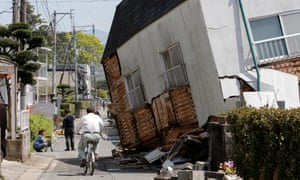Reports of people trapped inside buildings after second earthquake in as many nights in Kumamoto region

A powerful earthquake with a preliminary magnitude of 7.1 has struck southern Japan, barely 24 hours after a smaller quake hit the same region and killed nine people.
The quake shook the Kumamoto region at 1.25am local time, and several aftershocks soon followed. Japan’s meteorological agency issued an advisory for a tsunami of up to one metre high along the coast west of the epicentre. The warning was lifted less than an hour later.
The epicentre was about eight miles north-west of that of Thursday’s quake and shallower, at a depth of about 6 miles.
The Japanese broadcaster NHK said it had received a number of reports of people trapped inside houses and buildings. The sirens of emergency vehicles could be heard in the background as NHK reported from Mashiki, which was hardest hit by the previous quake.
The Nuclear Regulation Authority said no abnormalities had been found at the Sendai nuclear plant, where the only two of Japan’s 43 operable reactors are online.
NHK video showed that stones had tumbled from the walls of the historic Kumamoto Castle, and a wooden structure in the complex had been smashed, adding to damage caused on Thursday at the site.
At the Ark hotel east of the castle, guests woke up to strong shaking and a warning siren. Staff asked people to leave their rooms and gather in the lobby for safety.
Thursday’s weaker, magnitude-6.5 earthquake brought down buildings and injured about 800 people. More than 100 aftershocks followed. Since Saturday’s quake was bigger, Thursday’s was technically a foreshock.
Police said on Friday that concern about aftershocks was keeping many people from starting the task of cleaning up. About 44,000 people stayed in shelters after Thursday’s quake.
The dead included five women and four men, the Fire and Disaster Management Agency said. One man was in his 20s, and the rest of the victims ranged from their 50s to one woman in her 90s. Eight of the nine victims were from Mashiki.
There were varying reports on the number of injured. The government’s chief spokesman, Yoshihide Suga, said at least 860 people had been injured, 53 seriously. Kumamoto prefecture tallied 784 injured.
Suga said 1,600 soldiers had joined the relief and rescue efforts. TV reports showed troops delivering blankets and adult diapers to those in shelters. With water service cut off in some areas, residents were hauling water from local offices to their homes to flush toilets.
Most of Japan’s nuclear reactors remain offline following the Fukushima meltdowns in 2011 after a magnitude-9.0 earthquake triggered a tsunami.
Mashiki sits near two faults and is near Mount Aso, a huge, active volcano.

